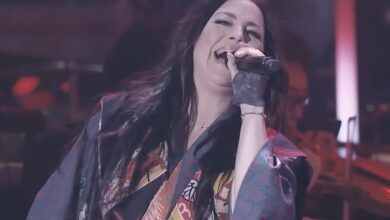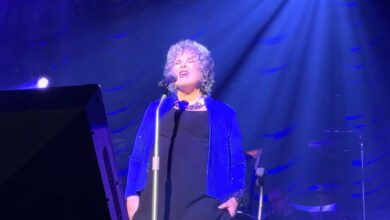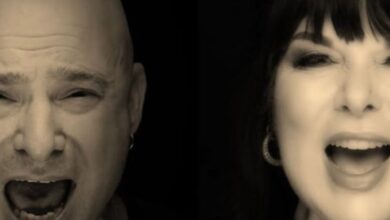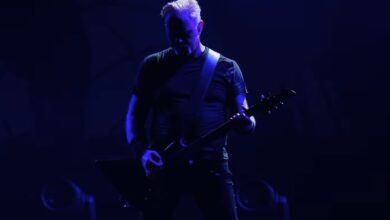Metallica Reignites Their Early Fury in Houston with “Creeping Death,” “For Whom the Bell Tolls,” and “Ride the Lightning”
On June 14, 2025, Houston’s NRG Stadium transformed into a thunderous shrine to heavy metal as Metallica unleashed a set that felt like a direct time portal to their ferocious early years. The night kicked off with the blistering opening of “Creeping Death,” and instantly, the crowd roared to life, fists pumping as James Hetfield’s growl pierced through the humid Texas air. It was clear from the first riff—Metallica wasn’t easing into anything.
Longtime fans who had seen them back when they opened for Guns N’ Roses felt a sense of déjà vu. There was no spectacle or delay—just straight, unfiltered metal. Lars Ulrich’s drums pounded with unrelenting energy, setting the pace for what would become one of the tightest opening trios of any show on their 2025 tour.
“Creeping Death” carried a certain historical weight. First released in 1984 on the Ride the Lightning album, the song has been a fan-favorite for decades, known for its “Die! Die! Die!” chant that always turns a crowd into a chorus. In Houston, the chant echoed so loudly it nearly drowned out the band, a moment of perfect harmony between artist and audience.
Without pause, they launched into “For Whom the Bell Tolls.” The iconic opening bass line rumbled across the stadium like an oncoming storm. Robert Trujillo delivered it flawlessly, nodding subtly to the legacy of Cliff Burton while putting his own fierce spin on it. Every head in the stadium moved in sync as Kirk Hammett’s lead guitar cut through the layered rhythm.
“For Whom the Bell Tolls” has always had a special place in Metallica’s live sets—an anthem that transcends age, with lyrics rooted in war and futility. In Houston, it felt deeply relevant, as the crowd swayed and roared with a mix of aggression and awe. The lighting cast deep shadows on the band, heightening the song’s ominous atmosphere.
Then came “Ride the Lightning,” and with it, a full-circle moment. Fans who had fallen in love with Metallica during the thrash-metal explosion of the early ’80s were now watching those very songs roar to life again. The title track from their 1984 album remains a technical marvel—its tempo shifts, layered solos, and lyrical chaos still electrify live audiences.
Hetfield’s rhythm guitar work was locked in, creating a wall of sound that perfectly supported Hammett’s swirling solos. The energy in the stadium peaked as the chorus hit, and the crowd responded like a single living entity—jumping, shouting, absorbing every note. It was an exhilarating display of how decades-old music can still stir something primal.
The Houston crowd was a melting pot of generations—original fans standing beside teens in brand-new Metallica shirts. Parents who saw the band in the ’80s now shared the experience with their children. The band seemed to sense that, often exchanging glances and smiles as if relishing the generational continuity unfolding before them.
Lars Ulrich, known for his expressive drumming and wild facial expressions, was in top form. He pushed every track forward with relentless precision, showing that age hadn’t dulled his edge. Every cymbal crash and double-kick burst felt sharp, punchy, and deeply connected to the pulse of the crowd.
There were no gimmicks—just raw performance. The stage setup was minimalist, with a few LED backdrops and spotlights that changed tone based on the mood of each song. But none of that distracted from the music. Metallica let the sound speak for itself, and in tracks like these, the message was crystal clear.
When the band finally took a brief pause to speak to the audience, Hetfield’s message was simple: “We’re still here. And we’re still loud.” It drew a massive cheer from the crowd, a shared acknowledgment that what they were witnessing was more than nostalgia—it was staying power.
The performance of this trio—“Creeping Death,” “For Whom the Bell Tolls,” and “Ride the Lightning”—was like watching three thunderclouds roll in and crash all at once. The transitions between the songs were seamless, and each one built upon the other in both intensity and technicality.
After the third song, a visible sense of satisfaction radiated through the stadium. It felt like the night had already peaked—but Metallica still had a full set to go. Fans looked at one another in disbelief, some laughing in awe, others hugging friends. It was one of those rare concerts where everything clicked from the very beginning.
The Houston heat, the flashing lights, and the sweat-soaked crowd only added to the grit of the night. There was something cathartic about singing along to lyrics that have lived in people’s hearts for forty years. Metallica wasn’t just playing songs—they were reconnecting memories, identities, and emotions buried in time.
For those in attendance, this sequence of three songs wasn’t just a highlight—it was the emotional anchor of the night. It reminded them of where Metallica came from, what they stood for, and why their music still matters in 2025. From the pit to the rafters, Houston felt the full weight of metal history come crashing down—and loved every second of it.





